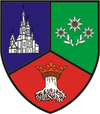Zărnești
Zărnești (Romanian pronunciation: [zərˈneʃtʲ]; German: Molkendorf, Zernescht; Hungarian: Zernest) is a town in Brașov County, Transylvania, Romania, with a population of 21,681. It administers one village, Tohanu Nou (Neu-Tohan; Újtohán).
Zărnești | |
|---|---|
 Coat of arms | |
 Location in Brașov County | |
 Zărnești Location in Romania | |
| Coordinates: 45°34′N 25°20′E | |
| Country | |
| County | Brașov |
| Government | |
| • Mayor | Alexandru-Lucian Igrișan (2016)[1] (PSD) |
| Area | 204.75 km2 (79.05 sq mi) |
| Population (2011)[2] | 23,476 |
| • Density | 110/km2 (300/sq mi) |
| Time zone | EET/EEST (UTC+2/+3) |
| Vehicle reg. | BV |
| Website | primaria-zarnesti |
It is located near the Piatra Craiului Mountains, which are part of the Southern Carpathians mountains range. Its close proximity to the Piatra Craiului make it a common start point for tourists and hikers wishing to explore "The Piatra Craiului National Park".
History
| Historical population | ||
|---|---|---|
| Year | Pop. | ±% |
| 1956 | 6,673 | — |
| 1966 | 17,628 | +164.2% |
| 1977 | 23,288 | +32.1% |
| 1992 | 26,319 | +13.0% |
| 2002 | 26,520 | +0.8% |
| 2011 | 21,681 | −18.2% |
| Source: Census data | ||
During the Roman period, soldiers of the Legio XIII Gemina were buried in the territory that is modern day Zărnești. It is first mentioned in the year 1373 under the name Zârna and also referred to as "possessio regalis Zerne" in 1395. Other names that appeared after 1437 are Zerna, Villa Czerne, and Zernyest.
Modern day Zărnești developed in the same location as the historic one. The commune of Tohan, which is now part of the town, was first mentioned in the year 1294, and remains among the oldest settlements in Romanian which have kept their name and location unchanged.
In 1690 Battle of Zernest Ottoman ally Imre Thököly defeated Habsburg forces, which enabled him to become Prince of Transylvania for a short time.
Due to the topographical diversity of Zărnești and surrounding area, agriculture became the primary occupation for its residents until not too long ago. Industrialization began sometime in the 1800s, with the construction of the paper manufacturing plant in 1852, then called Celuloza, now called Celohart – EcoPaper"[3]), and the weapons plant "6 Martie" in 1936. These projects turned Zărnești from a predominantly rural to an urban town.
In December 1939 disaster hit the town as 24 t of chlorine gas were spilled, killing 60, even at considerable distance from the plant where a storage vessel failed.[4]
The town of Zărnești developed largely in the communist era, bringing its population to 25,000 people, which contributed to the addition of a few neighborhoods of communist era blocs. In 1951, Zărnești was declared a town, of which Tohanul Vechi (Old Tohan) became a part of. In 1968, the commune of Tohanul Nou (New Tohan) was included in Zărnești proper. After the Romanian Revolution of 1989, the industrial plants closed, only to be sold piece by piece to private buyers.
Currently, Zărnești has enjoyed a spike in tourism, relieving some of the pressure of unemployment which followed the revolution.
Name
The Romanian name "Zărnești" is a derivation from zârnă (Black Nightshade[5]), a word of Slavic origin (from Old Church Slavonic зрьно, grain) and suffix -ești.
Notable people
- Ioan Bran de Lemény, lawyer, revolutionary, and Transylvania's first Romanian civil servant
- Lucian Clinciu, ski mountaineer
- Gheorghe Crăciun, writer and translator
- Dimitru Frâncu, ski mountaineer
- Ionuț Gălițeanu, ski mountaineer and mountain runner
- Eduard-Michael Grosu, Romanian professional racing cyclist, born in Zărnești
- Alexandru Ilie, professional footballer
- Rareș Manea and Silviu Manea, endurance sports athletes
- Ioan Mețianu, cleric of the Romanian Orthodox Church
- Traian Moșoiu, Romanian World War I-general, born in Tohanul Nou
- Ion Monea, Romanian boxing champion, born in Tohanul Vechi
Photo gallery
 View of valley of Zărnești
View of valley of Zărnești- View of the Piatra Craiului mountains from Zărnești
References
- "Results of the 2016 local elections". Central Electoral Bureau. Retrieved 3 April 2020.
- "Populaţia stabilă pe judeţe, municipii, oraşe şi localităti componenete la RPL_2011" (in Romanian). National Institute of Statistics. Retrieved 4 February 2014.
- "Celohart Zarnesti". Celohart Zărnești. Archived from the original on 21 May 2007. Retrieved 24 August 2008.
- "Integrated Regional Risk Assessment, Vol. II". Retrieved 27 September 2015.
- "zârnă". Dicţionarul explicativ al limbii române (in Romanian). Academia Română, Institutul de Lingvistică "Iorgu Iordan", Editura Univers Enciclopedic. 1988.
